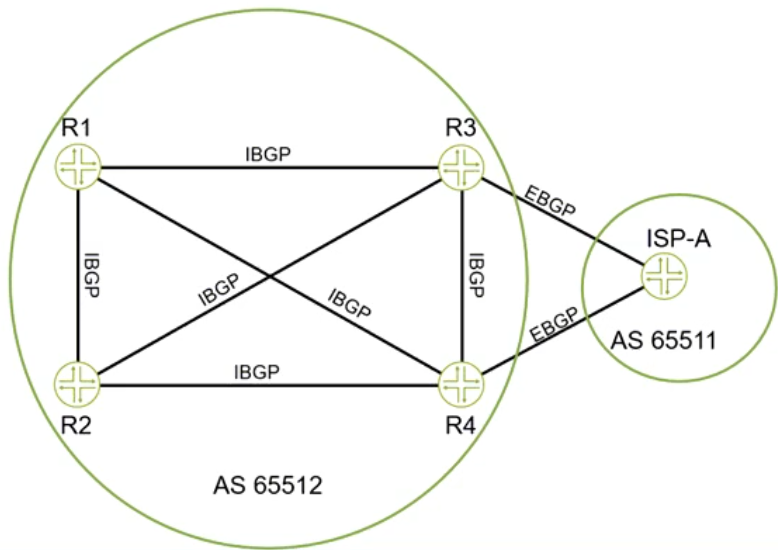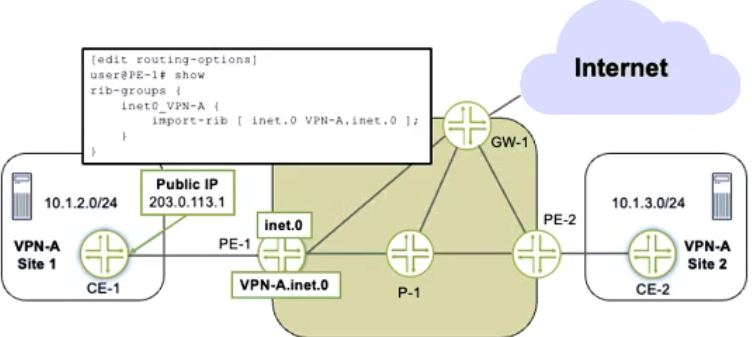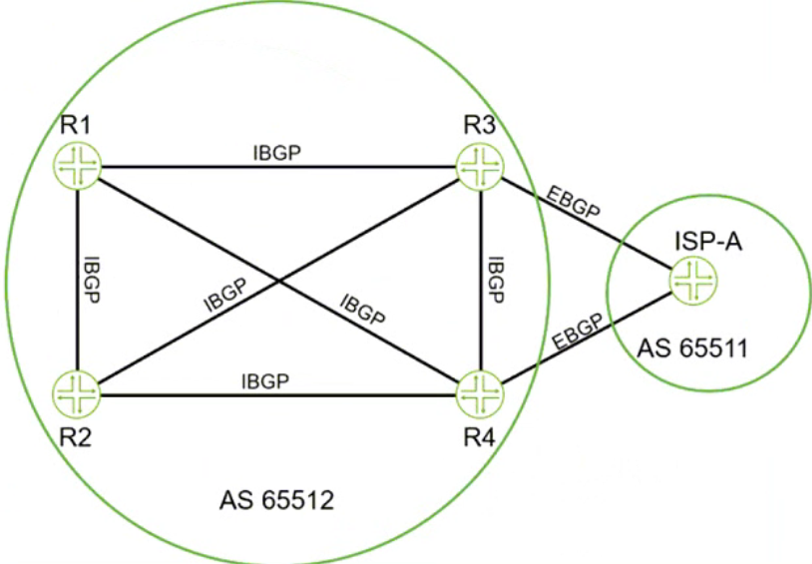Juniper jn0-664 practice test
service provider routing and switching, professional (jncip-sp)
Question 1
Click the Exhibit button.
Referring to the exhibit, which two statements are correct about BGP routes on R3 that are advertised to R1? (Choose two.)
- A. By default, the next-hop value for these routes is not changed by R3 before being sent to R1.
- B. By default, the next-hop value for these routes is changed by R3 before being sent to R1.
- C. By default, the BGP local-preference value that is assigned on R3 is advertised to R1.
- D. By default, all BGP attributes values must be removed before advertising the routes to R1.
Answer:
ac
Question 2
Click the Exhibit button.
Referring to the exhibit, you must provide VRF Internet access over a single connection for VPN-A Site 1, which connects to PE-1.
Which two statements are correct in this scenario? (Choose two.)
- A. You must use the RIB group to move interface routes from the inet.0 table to the VPN-A.inet.0 table.
- B. You must use the RIB group to move a default route, which is learned through BGP, from the inet.0 table to the VPN-A.inet.0 table.
- C. You do not need to use the RIB group to move interface routes from the inet.0 table to the VPN-A.inet.0 table.
- D. You do not need to use the RIB group default route, which is learned through BGP, from the inet.0 table to the VPN-A.inet.0 table.
Answer:
bc
Question 3
Click the Exhibit button.
Referring to the exhibit, the 10.0.0.0/24 EBGP route is received on R5; however, the route is being hidden.
What are two solutions that will solve this problem? (Choose two.)
- A. On R4, create a policy to change the BGP next hop to 172.16.1.1 and apply it to IBGP as an export policy.
- B. On R4, create a policy to change the BGP next hop to itself and apply it to IBGP as an export policy.
- C. On R4, add the internal IBGP interface prefixes to the BGP routing tables.
- D. On R4, add the external EBGP interface's prefix to the IGP routing tables.
Answer:
bd
Question 4
You are a network architect for a service provider and want to offer Layer 2 services to your customers. You want to use EVPN for Layer 2 services in your existing MPLS network.
Which two statements are correct in this scenario? (Choose two.)
- A. Segment routing must be configured on all PE routers.
- B. EVPN uses Type 2 routes to advertise MAC address and IP address pairs learned using ARP snooping.
- C. EVPN uses Type 3 routes to join a multicast tree to flood traffic.
- D. VXLAN must be configured on all PE routers.
Answer:
bc
Question 5
Click the Exhibit button.
You are running a service provider network and must transport a customer's IPv6 traffic across your IPv4-based MPLS network using BGP. You have already configured mpls ipv6-tunneling on your PE routers.
Which two statements are correct about the BGP configuration in this scenario? (Choose two.)
- A. You must configure family inet6 labeled-unicast between PE routers.
- B. You must configure family inet6 add-path between PE and CE routers.
- C. You must configure family inet6 unicast between PE and CE routers.
- D. You must configure family inet6 unicast between PE routers.
Answer:
ac
Question 6
Click the Exhibit button.
You want to use both links between R1 and R2. Because of the bandwidth difference between the two links, you must ensure that the links are used as much as possible.
Which action will accomplish this goal?
- A. Ensure that the metric-out parameter on the Gigabit Ethernet interface is higher than the 10 Gigibit Ethernet interface.
- B. Define a policy to tag routes with the appropriate bandwidth community.
- C. Enable per-prefix load balancing.
- D. Disable multipath.
Answer:
c
Question 7
Which two statements are correct about the customer interface in an LDP-signaled pseudowire? (Choose two.)
- A. When the encapsulation is vlan-ccc or extended-vlan-ccc, the configured VLAN tag is included in the control plane LDP advertisement.
- B. When the encapsulation is ethernet-ccc, tagged and untagged frames are both accepted in the data plane.
- C. When the encapsulation is ethernet-ccc, only frames without a VLAN tag are accepted in the data plane.
- D. When the encapsulation is vlan-ccc or extended-vlan-ccc, the configured VLAN tag is not included in the control plane LDP advertisement.
Answer:
ac
Question 8
Click the Exhibit button.
Referring to the exhibit, which two statements are correct about BGP routes on R3 that are learned from the ISP-A neighbor? (Choose two.)
- A. The next-hop value for these routes Is changed by ISP-A before being sent to R3.
- B. All BGP attribute values must be removed before receiving the routes.
- C. The BGP local-preference value that is used by ISP-A is not advertised to R3.
- D. By default, the next-hop value for these routes is not changed by ISP-A before being sent to R3.
Answer:
cd
Question 9
You are configuring anycast RP for load balancing and redundancy in your PIM-SM domain. You want to share active sources between RPs.
In this scenario, what are two solutions that will accomplish this task? (Choose two.)
- A. Configure MSDP on each RP router.
- B. Configure anycast PIM with the rp-set statement on each RP router.
- C. Configure anycast PIM with the rp-set statement on each source DR router.
- D. Configure MSDP on each source DR router.
Answer:
ab
Question 10
Click the Exhibit button.
Which two statements are correct about the class-of-service configuration shown in the exhibit? (Choose two.)
- A. The drop probability jumps immediately from 20% to 60% when the queue level reaches 75% full.
- B. To use this drop profile, you reference it in a scheduler.
- C. The drop probability gradually increases from 20% to 60% as the queue level increases from 50% full to 75% full.
- D. To use this drop profile, you apply it directly to an interface.
Answer:
bc